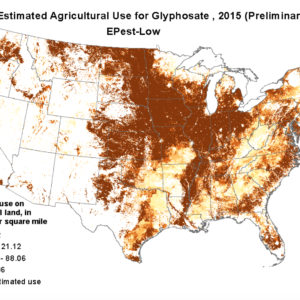Day 4 – Well Played, Dr. Portier

As if we never left, we are all back in the courtroom. The court reporter left two notes to SLOW DOWN. The group is definitely prone to rapid speak.
I am beginning to worry that Judge Bolanos is favoring the Defendants. I’m trying to trust in impartiality, but it seems that she is tying up the hands of the Plaintiff counsel in several instances. As the case unfolds, the fact that Plaintiff counsel is not permitted to set the stage for the jury regarding anything about the State of California’s view on glyphosate via Prop 65, nor mention the previous trials of Monsanto v California (OEHHA/California’s EPA), is increasingly absurd. (1)
Monsanto has been given free reign to discuss European agencies and what they think of glyphosate. How are legal decisions from the State of California non-pertinent, but Germany’s opinions are?
Back to Dr. Portier’s testimony.
We are shown two maps of the United States that are shaded to represent glyphosate use quantities. One is from 1993 and one from 2015. Look at that. Wisner questions Portier about why the use of Roundup went up so much in the 1990s, and Portier avoids any temptation to discuss the introduction of GMO crops. He just states that glyphosate use did explode starting in the 1990s.
-

- Explosion of glyphosate use due to the mid-1990s introduction of Roundup-Ready GMOs
REVIEW
Just to review, in Portier’s study on the carcinogenicity of glyphosate that he is presenting during this trial, he considered 13 animal studies, 6-7 epidemiology studies, and well over 100 studies of mechanistic data. We discussed the animal data yesterday and concluded it was strong. Wisner and Portier spent a great deal of time poring through the epidemiological studies, and Portier ultimately concludes that there is an association between NHL and glyphosate.
Now onto the final category of science, mechanistic data.
MECHANISTIC DATA
Mechanistic studies are divided into six types.
- Human (InVivo/InVitro)
- Mammals (InVivo/InVitro)
- Other animals (InVivo/InVitro)
After considering all of the mechanistic data, Portier focusses on the subcategories of genotoxicity and oxidative stress. I defined these terms on my Opening Statements blog page.
GEONOTOXICITY
We are shown a chart entitled Genotox Studies Table, listing relevant studies. Delving more deeply into the Human In Vivo studies, which Portier considers of highest importance:
- 2007: Paz-y-Miño studied the consequences of aerial spraying with glyphosate-based formulation in 24 exposed individuals (21 control) in Ecuador. The data showed a higher degree of DNA damage in the exposed group compared to the control, suggesting that the formulation used during aerial spraying glyphosate had a genotoxic effect. (3)
- 2009: Bolognesi studied the genotoxic risk of glyphosate in agricultural workers from within five Columbian regions. Four regions were sprayed for illicit crops and maturation of sugar cane. The control was an organic coffee farm. Blood was tested before the exposure, five days after spray and four months after spray. At the five day point, there was a significant increase in DNA damage in the blood samples of those who had been exposed. If there was no repeated exposure, that damage normalized by the final blood reading four months later. This study shows that repeated, chronic exposure to glyphosate leads to DNA damage, which ultimately can lead to cancer. (4)
- Follow-Up Paz-y-Miño study shows no genotoxic effect from spraying glyphosate, but blood results are taken two years after the spray. We know from the Bolognesi study that damage normalizes in four months, so any damage seen would have corrected in the two years since the spray.
Portier concludes that glyphosate is genotoxic and glyphosate formulations are genotoxic.
OXIDATIVE STRESS
There are only about twelve studies total on glyphosate/Roundup and Oxidative Stress. Those studies are in human and mammalian cells. Portier concludes that the evidence is strong enough to state that glyphosate can cause oxidative stress in mammalian cells.
THE CONCLUSION OF PORTIER’S SCIENTIFIC REPORT: Animal Studies, Epidemiology, and Mechanistic Data – with the totality of this evidence, it is highly probable that glyphosate causes cancer in humans, and that cancer is NHL.
PORTIER AND THE EPA
Wisner begins questioning Portier about the EPA. Portier believes that the EPA is soon to renew glyphosate as NOT LIKELY TO BE CARCINOGENIC. Portier helped to create the original document providing procedural guidelines as to how the EPA classifies carcinogenicity of substances. There are several levels in which a substance can be categorized, so YES/NO aren’t the only options. In this case, the EPA unequivocally says NOT LIKELY.
I am absolutely floored. With all of this evidence, how is the EPA coming to this conclusion?
Can you imagine being a world expert on toxicology and cancer – so incredibly skilled that you are asked to develop the scientific procedure for evaluating substances for the EPA and IARC – and watch as the EPA either intentionally or unintentionally can’t follow their own guidelines? A chemical with overwhelming animal studies and mechanistic data that shows it to be cancer causing?
I imagine there must be times in which he has wanted to punch a wall, scream in frustration or run really fast on a treadmill with incline. It’s like a nightmare in which there is an emergency and you need to call someone, but the numbers aren’t working and you can’t relay your message.
Portier submitted comments to the EPA when they were drafting their opinions on glyphosate, because: “This was just so incredibly wrong, what they are doing, that I just had to say something.”
EUROPE
In October 2015, the German Federal Institute for Risk Assessment (BfR) prepared a Renewal Assessment Report for the European Food Safety Authority (EFSA). EFSA is the primary agency of the European Union for risk assessments regarding food safety. BfR and EFSA concluded that “glyphosate is unlikely to pose a carcinogenic hazard to humans and the evidence does not support classification with regard to its carcinogenic potential.”
Portier sent comments to the Commissioner of Health who instructed EFSA to respond. Portier recruited nearly 100 scientists to coauthor a letter: Differences in the carcinogenic evaluation of glyphosate between the IARC and the EFSA. (5)
At EFSA, the highest classification is 1A. Following their own guidelines, glyphosate should be classified as a 1B.
Wisner asks Portier where Roundup is banned. Before he has a chance to respond, Monsanto objects and they go to sidebar. A bit more questioning, and Monsanto is up.
MONSANTO’S TURN
Attorney Kirby Griffis stands to set up for his cross-examination of Portier. He apparently likes to work from a podium, so he starts pushing a podium over to the left side of the courtroom where the jury, Portier and Wisner sit.
It looks like Griffis is settling in, and I hear Wisner say, “OK, THIS ISN’T GOING TO WORK!” I look again, and Griffis has rolled the podium to a position about one foot in front of Wisner’s seat, blocking his view of everything but Griffis’s rear. And he’s no Sir Mix-A-Lot muse.
Griffis awkwardly tries to stretch the microphone cord, which already appears to be on its last wirey legs. Wisner continues, “This just doesn’t seem like a good idea.” Truly, this is like a Dwight and Jim moment and I can’t stop laughing.
Finally, everyone is in place. Questioning begins.
Monsanto boldly posts documents and evidence without asking permission of the Plaintiff nor the judge. Bolanos lets this continue, until Wisner points out the enormous double standard. Monsanto not only displays documents without asking for objections, but also has reformatted them on their pretty blue sunshiny slides, boxing and highlighting to emphasize their points. For frame of reference, the Plaintiff counsel puts documents up in their original format.
There are hours of questions and Portier gets increasingly annoyed as Griffis tries to discredit him. Griffis discusses the idea of false positives and asks how many of the animal studies may have simply been false positives. Portier says some studies could potentially have false positives, but not all.
Remember that grand posterboard of tasteful colors? It proudly re-enters the arena, resting on an easel. I now understand the board to double as a dry-erase surface.
Griffis asks Portier to put a big X through the studies on the chart that may hold false positives. Portier obliges, takes the pen and crosses out a study. Well, the pen is a sharpie. Wisner says, “Not THAT pen!!! That board is expensive!” Griffis does not appear to feel bad about it, which makes me think that it was intentional to ruin the posterboard of positive studies with Xs in permanent markers.
POINTS
- After discussing the EFSA and EPA reports, Griffis repeatedly quotes Portier’s earlier reaction that the conclusions are “so amazingly wrong,” in an attempt to paint Portier as over-reactive and hotheaded. Hardly hotheaded, Portier is sharp and collected.
- Griffis unsuccessfully tries to depict Portier as a person acting with conflicts of interest. He suggests that Portier was working as a consultant with a US law firm before the IARC meeting. Portier says absolutely not, though law firms were contacting him. He did ultimately sign a contract with a law firm to consult on cellphone and glyphosate litigation nine days after the IARC announcement.
- Griffis discusses how Portier was involved with lobby agencies to fight regulatory conclusions on glyphosate. Portier says he absolutely has never been part of a lobbying organization, and merely responds to reports during the public comment period.
- Portier is asked if he nominated himself to be head of IARC. He says he did but did not get the position.
In the hours of questioning, the overall takeaway is that Monsanto wants to throw shade on Portier’s reputation, reasoning and analysis, but they simply aren’t smart enough to do so. With each question, Portier is fast to respond with brilliant answers. It seems that the Defendant counsel could stand some serious refreshers on null hypotheses, p-values, statistical significance and trends, because some questions make them look out of their league.
Back in court on Monday!
© 2018 Kelly Ryerson ALL RIGHTS RESERVED

